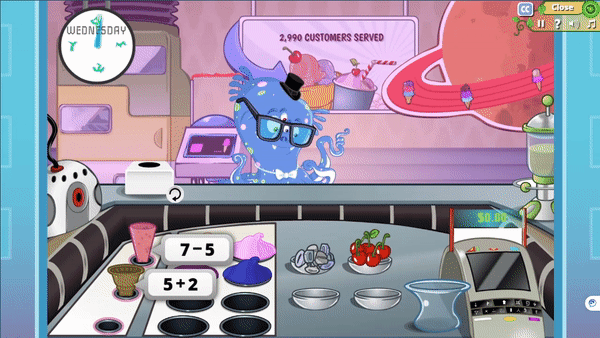How Reflex Builds Math Fact Fluency Through Paired Math Operations

Educators know that math fact fluency saves students time and significantly impacts their future math success. Extensive research about the critical role of math fact fluency shows that when students develop fact fluency, they free up their working memory to retrieve math facts with little effort. This allows them to devote more time to advanced problem-solving and learning new skills.
How does Reflex teach math fact operations?
Math operations refer to the four fundamental operations of addition, subtraction, multiplication, and division. ExploreLearning Reflex combines research-proven methods with adaptive games to provide the most effective math fact fluency solution to teach math fact operations.
While some math fact programs separate the operations, Reflex teaches them together. Reflex continuously monitors each learner’s math performance to help students of all levels develop math fact fluency. Reflex keeps students motivated through engaging games and frequent rewards for effort progress. Educators have everything they need to monitor and celebrate individual and classroom fact fluency progress with Reflex's reporting features.
Evidence-based reasons to teach math fact operations together
Reflex helps students build speed and accuracy with math fact families, showing the relationship between the operations. Instead of learning facts for addition and subtraction or multiplication and division separately, Reflex shows students how the operations relate to one another.
The math fact family approach centers on conceptual understanding of the operations' relationships while also facilitating procedural understanding. When math facts (or fact families) are presented together, solving problems is ultimately easier and more efficient because students are able to see how they relate to one another.
Math fact operations have reciprocal relationships
Because these operations are reciprocal relationships, presenting them together helps students understand connectivity. Teaching math fact operations together gives students an understanding of how the relationships work together.
Consider that 5 x 9 = 45. It’s also true that 45 ÷ 5 = 9. Showing the relationship between the operations makes it less intimidating for students to think about learning facts because there are fewer fact families to learn. When math fact operations are presented together, it naturally helps students understand the nature of inverse operations.
Reflex’s math-fact family approach builds conceptual understanding
Reflex supports students’ learning through a fact family approach to teaching new facts because it works. What is a fact family? A math fact family is a group of related math facts using the same three numbers. Think of the relationship between two addition facts and two subtraction facts or two multiplication facts and two division facts. Fact families show how the same three numbers can be combined and separated through math operations.
Teaching math fact operations builds number sense
When teachers talk about number sense, they refer to the ability to relate numbers to the quantities they represent. With Reflex, students build speed and accuracy through math fact families, which also helps them grow number sense.
Teachers can encourage the growth of number sense by offering various opportunities for students to work with numbers. Some activities or ideas to engage students with numbers to build number sense include puzzles, estimation, counting, grouping, time, and math discourse.
Why is understanding reciprocal relationships so important for learning math?
Understanding reciprocal relationships in math builds a foundation for how numbers relate to each other. Students who recognize inverse relationships between numbers and their reciprocals gain a procedural and conceptual grasp of the different math operations.
That understanding opens the door to more complex mathematical concepts like fractions and algebra. When students are fluent with addition, subtraction, multiplication, and division facts, the ability to tackle more advanced math is unlocked. No more counting on their fingers or making tally marks! Students can dedicate their energy to new skills, such as comparing fractions, multi-step problems, or word problems.
Experience Reflex today
Reflex always presents new facts as fact families, which helps students view them as one related set of numbers rather than four separate facts to learn – building conceptual understanding through fact families. For a research-based tool that builds math fact fluency through proven teaching strategies, look no further than Reflex. Take a free trial today!
“Reflex is much more engaging for students and is significantly more effective in the approach. Having students learn facts in fact families has helped students master substantially more facts than previous programs that I have used. (...) Now, students are excited to practice their facts. They have been able to focus more on practical math applications rather than attempting to recall facts.”
-Grade 3 Teacher. Grosse Pointe Public School System, MI

